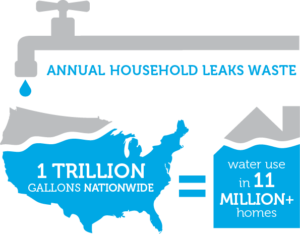Household leaks account for more than 1 trillion gallons of water wasted each year in U.S. homes. In addition to needlessly wasting this precious natural resource, leaks also cost homeowners money. Fixing household leaks can save homeowners about 10% on their water bills. Common types of leaks found in the home include worn toilet flappers, dripping faucets and showerheads, and other leaking valves. All are easily correctable.*

How to Check for Leaks
- Check your water meter before and after a two-hour period when no water is being used. If the meter does not read exactly the same, you probably have a leak.
- Check faucets for leaks by monitoring for drips of water under sinks and from exposed pipes. Check for drips when the faucet is in the on and off position.
- Check toilets for leaks by placing a few drops of food coloring in the toilet tank. If the color shows up in the bowl within 15 minutes without flushing, you have a leak. Flush immediately after this experiment to avoid staining the tank.
- Monitor your water bill. If water usage spikes without any obvious change to indoor and outdoor water use patterns, you may have a leak.
Repairing Leaks*
Faucets – Leaky faucets can be fixed by checking faucet washers and gaskets for wear and replacing them if necessary.
Showerheads – Most leaky showerheads can be fixed by ensuring a tight connection using pipe tape and a wrench.
Toilets – If your toilet is leaking, the cause is often an old, faulty toilet flapper. Over time, this inexpensive rubber part decays, or minerals build up on it. It’s usually best to replace the whole rubber flapper—a relatively easy, inexpensive do-it-yourself project that pays for itself in no time.
If you still suspect a leak after following these steps, you may need to contact a plumber.
The Facts about Leaks*
- Household leaks can waste more than 1 trillion gallons annually nationwide. That’s equal to the annual household water use of more than 11 million homes.
- The average household’s leaks can account for more than 10,000 gallons of water wasted every year, or the amount of water needed to wash 270 loads of laundry.
- Ten percent of homes have leaks that waste 90 gallons or more per day.
- A leaky faucet that drips at the rate of one drip per second can waste more than 3,000 gallons per year. That’s the amount of water needed to take more than 180 showers!
- A showerhead leaking at 10 drips per minute wastes more than 500 gallons per year. That’s the amount of water it takes to wash 60 loads of dishes in your dishwasher.
About EPA’s WaterSense Program*
The Springfield Water and Sewer Commission is a member of the US EPA’s WaterSense program.
WaterSense, a partnership program sponsored by the EPA, seeks to protect the future of our nation’s water supply by offering people a simple way to use less water with water-efficient products, new homes, and services. Since the program’s inception in 2006, WaterSense has helped consumers save 487 billion gallons of water and $8.9 billion in water and energy bills. For more information on the WaterSense program, visit www.epa.gov/watersense.
*Courtesy of EPA WaterSense webpage.